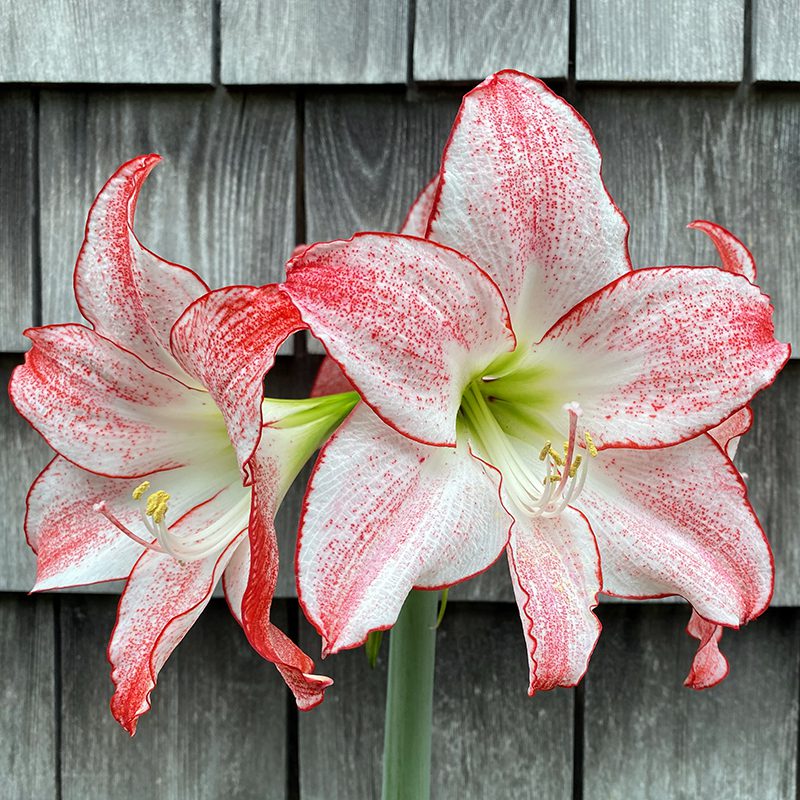What To Do With Your Amaryllis Bulbs in Fall
What To Do With Your Amaryllis Bulbs in Fall
If you had a lovely amaryllis in flower last winter, it’s likely that you decided to keep it alive all summer so that it will come into flower again. Hopefully, the plant was outside in part-shade for the summer, watered once a week or when the soil looked dry, and fertilized. Given that treatment, the bulbs will store energy and be ready to bloom again in December. Here are the steps you should be taking now.
Pull any weeds from the pots.
Sometimes weed seeds blow into the pots when they’re outside, and you’ll find random plants are now keeping company with your amaryllis bulb. It’s time to evict any weeds that are growing in your pots.

Decide if the bulbs need new pots or fresh soil.
Sometimes the soil that surrounds amaryllis bulbs gets washed out of the pot, or compacted over a summer. If that has happened, you can add soil to the top or the bottom of the bulb before you bring it inside for a resting period. If you’ve kept a bulb in the same pot for two or more years, it’s a good idea to refresh the potting soil. Yes, you could do that later, when the plant is dormant and ready to bring back indoors, but in September you can do the messy repotting outside.
If your amaryllis bulb has produced new, smaller bulbs to the side of your original plant, you can also repot or reposition that smaller offshoot so that it has room to grow larger. When you are repotting, cut off any yellow or dead leaves but leave the green ones on the bulbs for now.


Bring pots of amaryllis into a cool place before frost.
Once you have cleaned up your potted amaryllis and done any repotting that is needed, on Cape Cod you can leave the pots outside until the end of September. (Those who live in colder areas where a hard frost is common in September should bring these bulbs directly into their resting area.) Once temperatures start dropping into the 40’s overnight, however, it’s time to bring the plants inside.
Leaving the green leaves on, put the pots of amaryllis in a cool basement or garage for their resting period. The place where you put them doesn’t need to be dark, but do keep them away from a sunny window. Stop watering the plants.

Once the leaves turn yellow or brown, cut them off.
After two or three weeks the leaves will start to yellow or shrivel. Cut them off at this point. Leave the pots of bulbs in the cool location, unwatered, for six to eight weeks.

After the resting period is over, bring the pots inside by a sunny window.
After six to eight weeks, move the pots back indoors. Water the soil well to rehydrate so that the bulbs generate new roots. Since the potting soil is likely to be very dry, you might have to water it repeatedly when you first bring the pot in, since much of the first watering is likely to drain out in the gap between the dry soil and the pot. I find that it’s easiest to do this by putting the pot in the kitchen sink, running water over the soil surface every five to ten minutes over a thirty minute period. Once the soil is well watered, move the pot to a warm location in front of a sunny window.
Given this treatment, most amaryllis bulbs produce a bloom spike within a few weeks time. Some will make leaves along with the flower stem, while others will grow a flower first, followed by leaves as the flowers fade.
Occasionally, a bulb will just make leaves. If this happens to you, move that plant into a sunny window, give it some fertilizer and water when dry. I find that a time release fertilizer such as Osmocote or Shake n’ Feed is a convenient way to feed these plants. When using a time release product, apply it right after the flowers fade and again in May when you put the plant back outdoors.

Sometimes, an amaryllis is on its own clock…
With plants we should always be willing to be surprised. Occasionally an amaryllis decides not to flower in the winter, and sometimes they flower twice. Be on the lookout for new flower stems at any point.

Subscribe To Our Newsletter
Sign up for our weekly email about sales and events.
